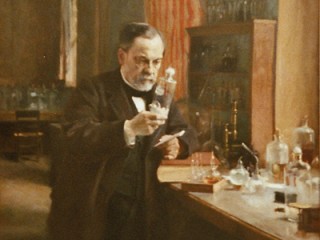
Louis Pasteur (En.) biography
Date of birth : 1822-12-27
Date of death : 1895-09-28
Birthplace : Dole, in Jura region of France
Nationality : French
Category : Science and Technology
Last modified : 2010-11-15
Credited as : Chemist, and microbiologist,
28 votes so far
Childhood
Louis Pasteur was born as Louis Jean Pasteur on 27th December 1822, in Dole, which is in the Jura region of France. He was the son of Jean Pasteur, a weakly educated tanner and a decorated Sergeant-Major of the Grande Armee. Though he was born in Dole, he spent the majority of his childhood in the town of Arbois. It was Pasteur’s college headmaster who recognized his extraordinary talent and aptitude. In fact, he also advised Pasteur to apply for the École Normale Supérieure. Pasteur did follow his advice and managed to gain admission in the elite institution.
Early Life
In 1848, Pasteur joined Dijon Lycée, as a professor of physics, for a brief period. In the year 1849, he was appointed as the professor of chemistry at Strasbourg University, with the help of M. Puillet. It was here that he met Marie Laurent, daughter of the University Rector, and fell in love with her. The couple got married on 29th May 1849. The matrimonial alliance produced five children, of which only two survived till adulthood. Right from the time he began understanding the world around him to the time he left for the holy abode, Pasteur remained an ardent Catholic.
Career
Pasteur was interested in chemistry and microbiology since a very young age. His first notable work in chemistry came in 1849, when he resolved a problem related to the nature of tartaric acid. He deduced the reason why there was no polarizing effect on the light, in case of tartaric acid derived by chemical synthesis. With this, he became the first person to demonstrate chiral molecules and also attracted the attention of M. Puillet. In 1854, Pasteur became the Dean of the new Faculty of Sciences in Lille. Two year later, he was made Administrator & Director of scientific studies, in École Normale Supérieure.
In the field of microbiology, Pasteur is credited with developing vaccines for a number of diseases. Amongst his most notable works has been the vaccine for cholera, which was the result of injection of chicken with spoiled culture of the responsible bacteria. Later, he applied the same immunization method to anthrax, which affected cattle. The rabies vaccine was initially created by Emile Roux, a French doctor who has tested it only on dogs. However, it was Pasteur who, on personal risk, used it on a human, a 9-year old boy. Many other vaccines as well as first of the Pasteur Institutes were later built on this achievement.
Later Years and Death
In 1895, Pasteur was awarded Leeuwenhoek Medal, the highest honor in microbiology. He was also a Grand Croix of the Legion of Honor, one of only 75 throughout France. He left for the holy abode, in 1895, the result of a series of strokes that had started in 1868. Pasteur was initially buried in the Cathedral of Notre Dame. However, later, his remains were re-interred in a crypt in the Institut Pasteur, Paris. His re-interment is an incredibly rare honor in France. This is because, in the country, it is mandatory to be buried in a cemetery. Only 300 "Great Men", including Pasteur, have the honor of being buried elsewhere.
















